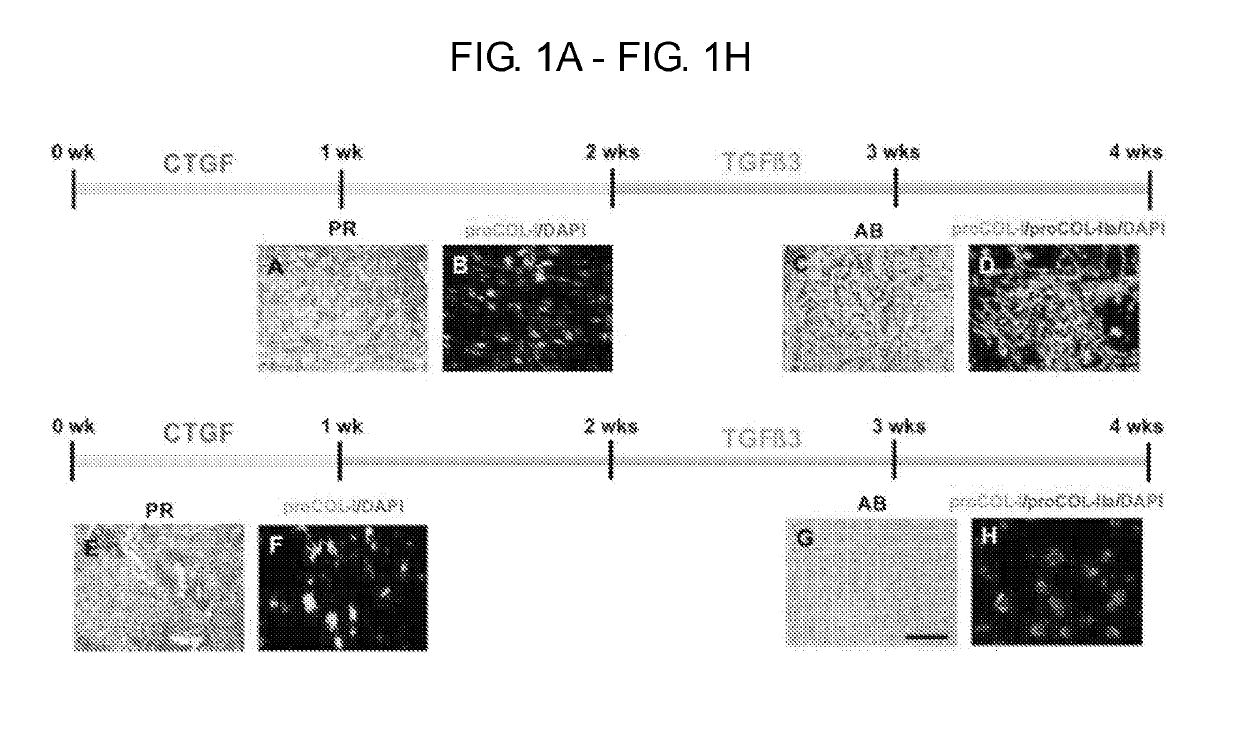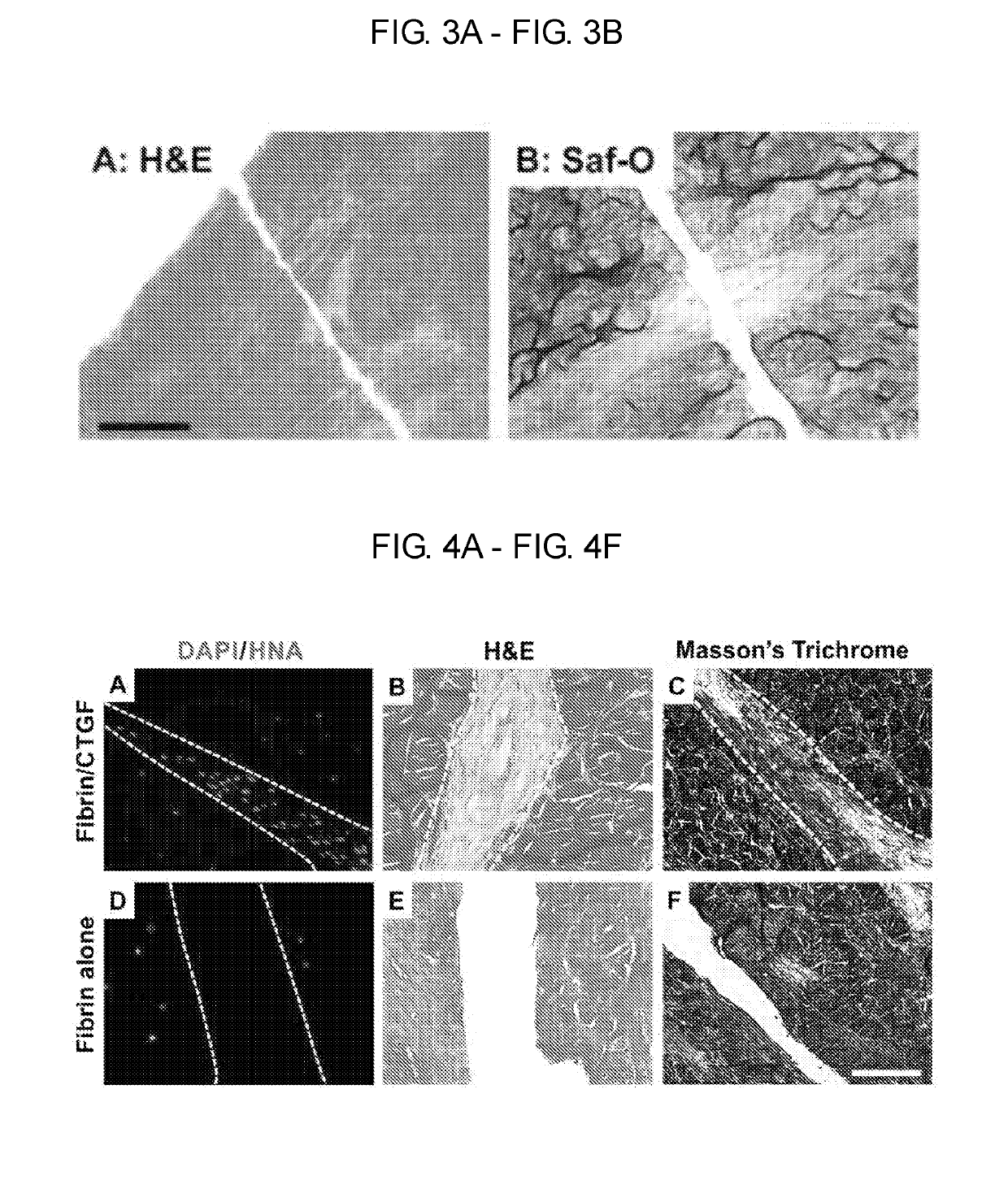Tissue repair by stem cell recruitment and differentiation
- Summary
- Abstract
- Description
- Claims
- Application Information
AI Technical Summary
Benefits of technology
Problems solved by technology
Method used
Image
Examples
example 1
Fibrochondrogenic Differentiation of Mesenchymal Stem / Progenitor Cells
[0229]The following example shows that treatment with a profibrogenic factor for a limited duration, followed by chondrogenic stimulation can induce step-wise differentiation of bone marrow or synovium MSCs into fibrochondrocyte-like cells.
[0230]More specifically, the following example shows a novel strategy to induce seamless healing of inner meniscus repairs (see e.g., FIG. 1). Chemotaxis or other profibrogenic factors (e.g., CTGF) are applied to the torn meniscus via fibrin glue to recruit synovium MSCs into the torn site, followed by formation of fibrous integration. Then the intermediate fibrous matrix is remodeled to cartilaginous tissue by inducing chondrogenic differentiation with growth factor treatment (e.g., TGF-β3). Consistent in meniscus development, the following example demonstrates premature COL-I rich fibrous tissue (E16 & P8w) differentiates into fibrocartilage (Pazin+JOR 2014) (see e.g., FIG. 1)...
example 2
Parameter Determination for Multiple Cytokines / Growth Factors
[0233]The following example determines optimal doses, sequence, and duration of multiple cytokines / growth factors to induce temporally controlled stem cell recruitment and step-wise differentiation for inner meniscus healing in vitro.
[0234]Various delivery strategies were applied, including local delivery, controlled release, and exogenous treatment, to find the optimal doses, sequence, and duration of each growth factor to lead to the seamless healing of inner meniscus tears.
[0235]It is presently thought that the stem / progenitor cells giving rise to meniscus fibrochondrocytes follow a step-wise differentiation: intermediate fibrogenic differentiation followed by chondrogenic differentiation (see e.g., FIG. 1). Given that collagenous fibrous matrix is the default filler for tissue repair, integration and remodeling, the induction of intermediate fibrous matrix in the torn meniscus is presently thought to provide initial in...
example 3
ize Tissue and Cellular Phenotypes in the Healed Meniscus
[0241]The following examples characterize tissue and cellular phenotypes in the healed meniscus using histology, qRT-PCR, nano-indentation, computerized histomorphometry, and immunohistochemistry.
[0242]Previous studies have rarely characterized healed meniscus tissues thoroughly and completely. It is presently thought that chondrocyte-like cell population and cartilaginous extracellular matrix are significant for long-term stability and functions in inner meniscus healing. This study shows avascular zone-specific distribution of extracellular matrix in the native meniscus can be recapitulated in a healed meniscus. This Example describes in-depth characterization of cell and tissue phenotypes in the healed meniscus tissue using multi-level analysis methods. Given the importance of mechanically stable integration for functional restoration of meniscus, pull-out tests are performed to analyze the integration strength, and nanoind...
PUM
| Property | Measurement | Unit |
|---|---|---|
| Time | aaaaa | aaaaa |
| Time | aaaaa | aaaaa |
| Time | aaaaa | aaaaa |
Abstract
Description
Claims
Application Information
 Login to View More
Login to View More - R&D
- Intellectual Property
- Life Sciences
- Materials
- Tech Scout
- Unparalleled Data Quality
- Higher Quality Content
- 60% Fewer Hallucinations
Browse by: Latest US Patents, China's latest patents, Technical Efficacy Thesaurus, Application Domain, Technology Topic, Popular Technical Reports.
© 2025 PatSnap. All rights reserved.Legal|Privacy policy|Modern Slavery Act Transparency Statement|Sitemap|About US| Contact US: help@patsnap.com



